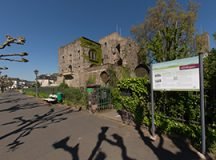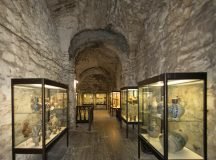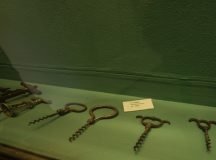Story and Photos by Kevin S. Abel
USAG Stuttgart Public Affairs Office
Weinmuseum Brömserburg (Brömser-burg Wine Museum), tells the Rüdesheim area’s 1,000-year wine growing history in one of the oldest castles in the Rhine River Valley.
The Brömserburg in Rüdesheim is one of the oldest castles along the Rhine River. The former fort, which was once surrounded by water, was built around 1000 A.D. as an early castle of the archbishops of Mainz, was rebuilt as a residence about 1200A.D. and later belonged to the knights of Rüdesheim. Since 1950, it has housed the Weinmuseum.
The castle offers the world’s oldest wine-related collection, ranging from wine and drinking vessels made out of different materials, to hundreds of bottles and labels, to tools and equipment used by coppers, cellar men and wine-growers. A fascinating history is provided in several languages.
The still preserved walls of the former moated castle date from the 12th century.
The castle itself is situated in a garden beside the Rüdesheim Rheinstraße, just a short walk away from the famous
Drosselgasse. In a journey through the history of wine, visitors experience the Brömserburg: 2,000 wine-related exhibits from the past to the present day.
At the entrance of Rheinstraße is a winery statue, 6000 liter wine barrel, barrel and crate carts, and a large number of presses throughout the garden to see.
In the halls and vaults of the castle a large number of wine and drinking vessels from early times to modern day including ceramic vessels from the Middle East, ancient Greece and the Roman Empire.
You will also find collections of Roman glasses and medieval wine jars from the Rheingau ceramic centers of Aulhausen and Dippenhausen, along with stoneware, cans and cups of tin and precious metals from the 16-19th centuries.
Also on display is collection of wine, brandy and schnapps glasses, in all major European styles from the Middle Ages through the Renaissance, Baroque and Rococo and Biedermeier to Art Nouveau and Art Deco.
Ancient sculptures illustrate the importance of wine in mythology and religion, explain the cult of Dionysus (god of the grape harvest, winemaking and wine, of ritual madness, fertility, theatre and religious ecstasy in Greek mythology) and a Christian era collection of measuring cups and jugs and a representation of a wine saint.
You will find wine bottles of different shapes from the 17th century to modern times, wine labels, decorative cork and corkscrew and tools of the winemaker, winemaker and barrel copper.
If you venture through the small winding staircases and work your way up, great views from the roof and the terrace await you of the Rhine River and surrounding vineyards.
Besides offering information on the history of wine, the Brömserburg also gives visitors the opportunity to try different wines. There are self-guided audio tours available in multiple languages to assist you in your visit. To enjoy the special exhibits and get a full museum experience allow yourself at least two hours.
Rüdesheim is a tourist town filled with half-timber houses, narrow streets, and old inns give the town a medieval character. On the edge of town on top of the Niederwald is a monument that was built between 1877 and 1883 to commemorate the re-establishment of the German Empire in 1871, after the end of the Franco-Prussian War. The 125 foot tall monument represents the union of all Germans. The monument can be reached by gondola lift from Rüdesheim to Niederwald, by car from Assmanshausen or by trail on foot.
Every September Rüdesheim holds a wine festival; it is also known for its brandy and Sekt, a sparkling wine. Its location, architecture, and wines make the town a favored stop along the Rhine for tourists.
If your travels permit, you can catch a ride down the middle Rhine on a number of small ships that travel the waterway giving a view of castles along the way. As most ships travel from Mainz to Cologne, and some of these ships also offer special dinner and dance cruises.
During your visit to the Rhine, immerse yourself in the magical atmosphere created by fountains of fire reflected in the waters of the Rhine and the thunder of the fireworks echoing from the steep banks. Around 50 ships join a flotilla that glides below perhaps the most elaborate _ reworks to be seen in Germany. The surrounding Middle Rhine Valley erupts in a final climactic display of pyrotechnic art during select days of the summer called Rhein in Flammen (Rhine in Flames). The biggest Rhein in Flammen event takes place in Koblenz every year, on the second Saturday in August. More information on Rhein in Flammen can be found at http://www.rhein-in-flammen.com.
Opening times — Mid-March to late October daily 10 a.m.–6 p.m.
Address — Rheingau Wine Museum, Brömserburg, Rheinstraße 2, 65385 Rüdesheim am Rhein
Telephone — +49 (0) 6722-2348
GPS — 49.9776, 7.9179
Fee — €5
Stroller/ADA Friendly — No
Website: www.rheingauer-weinmuseum.de



